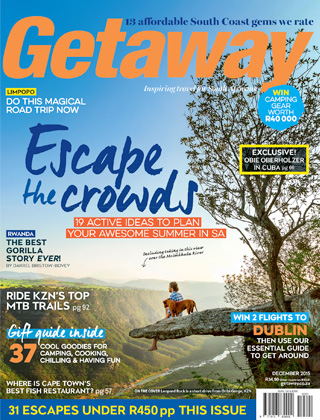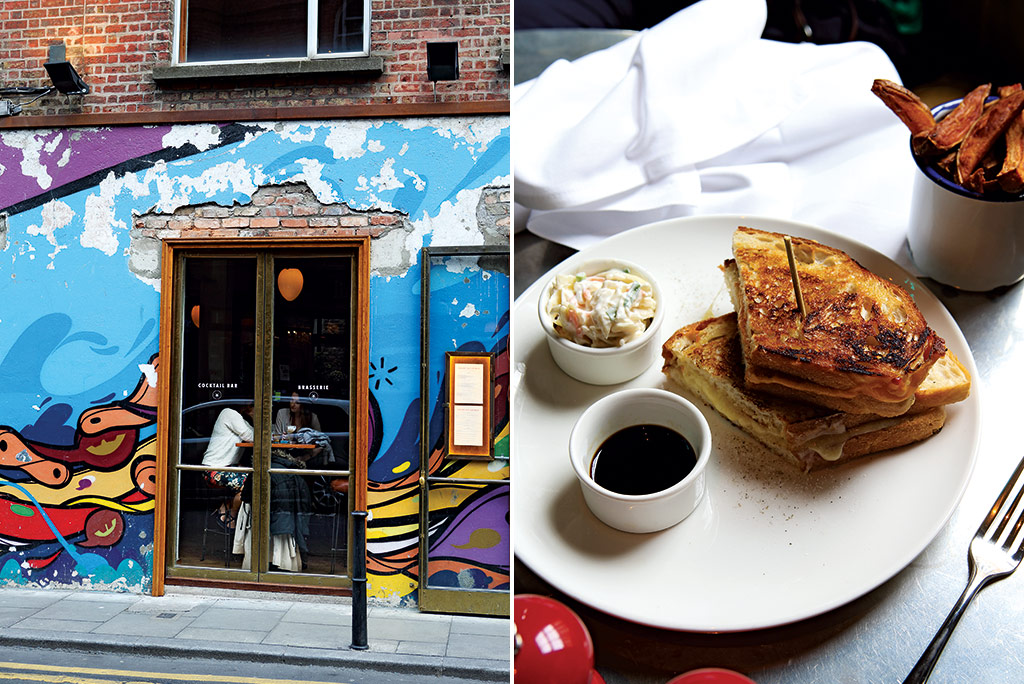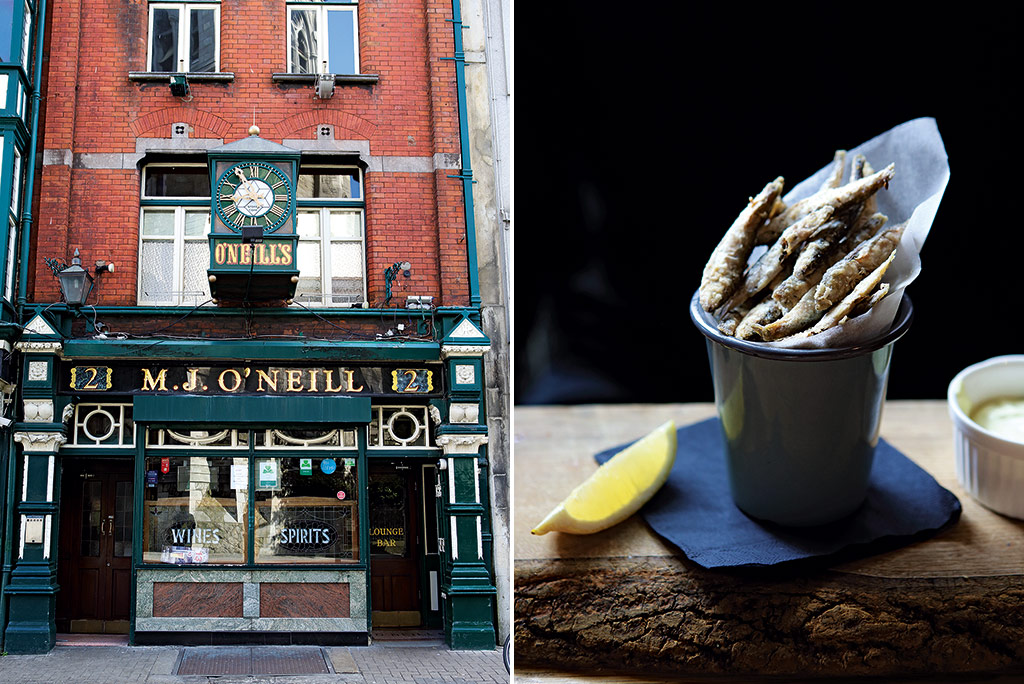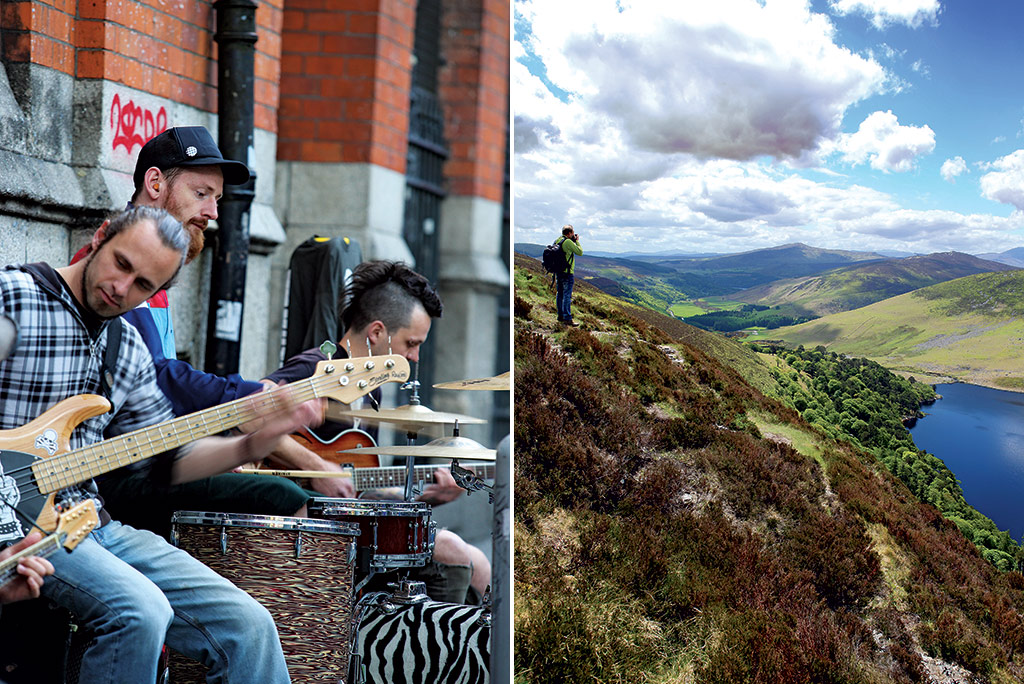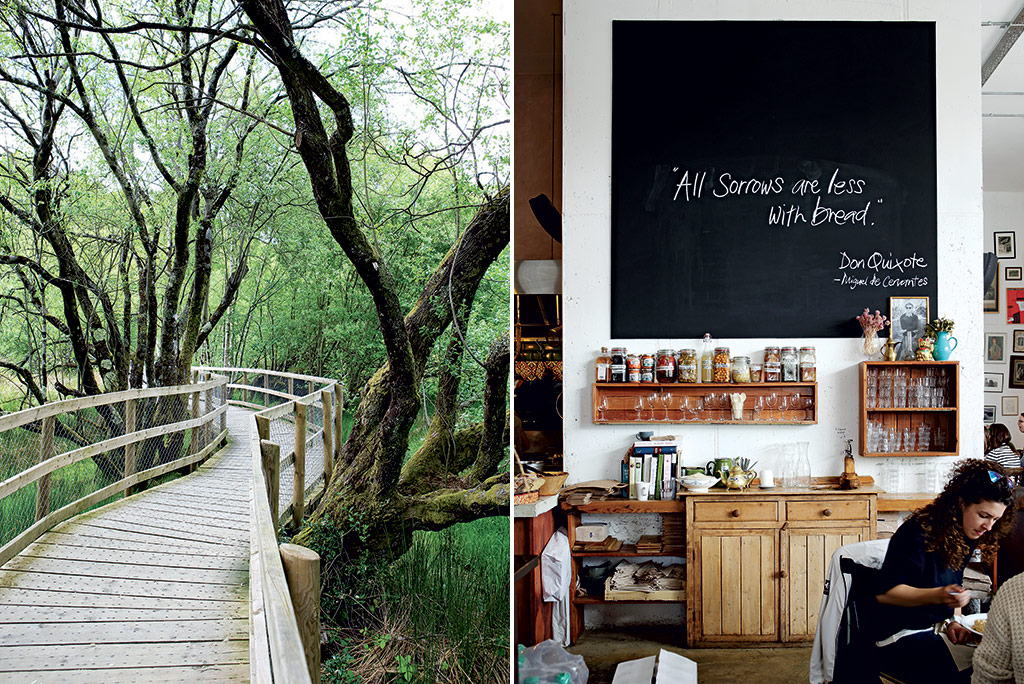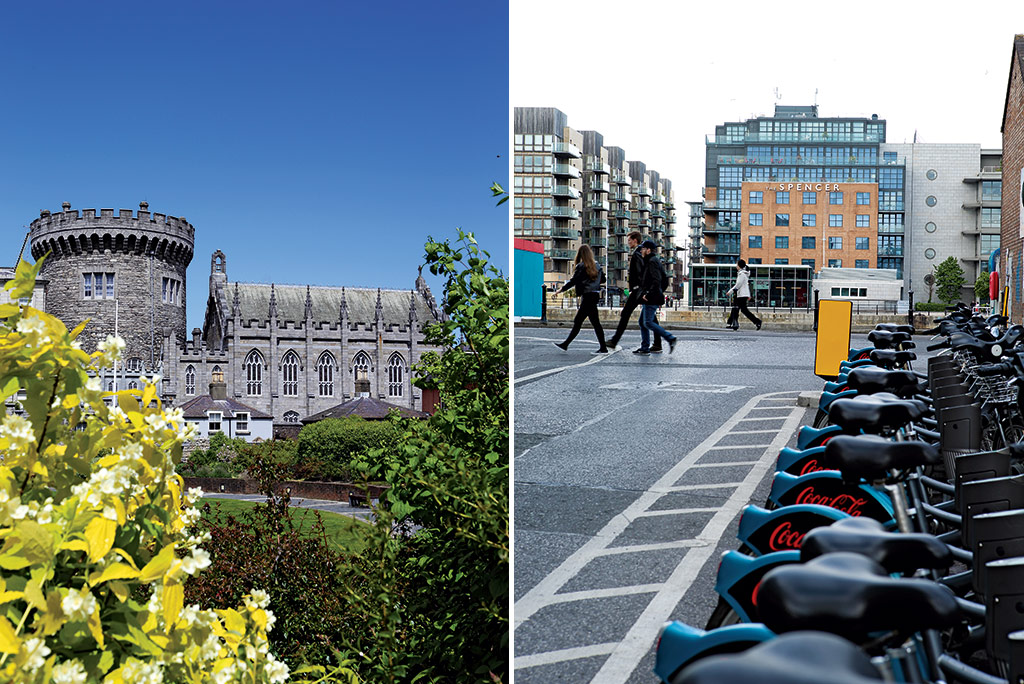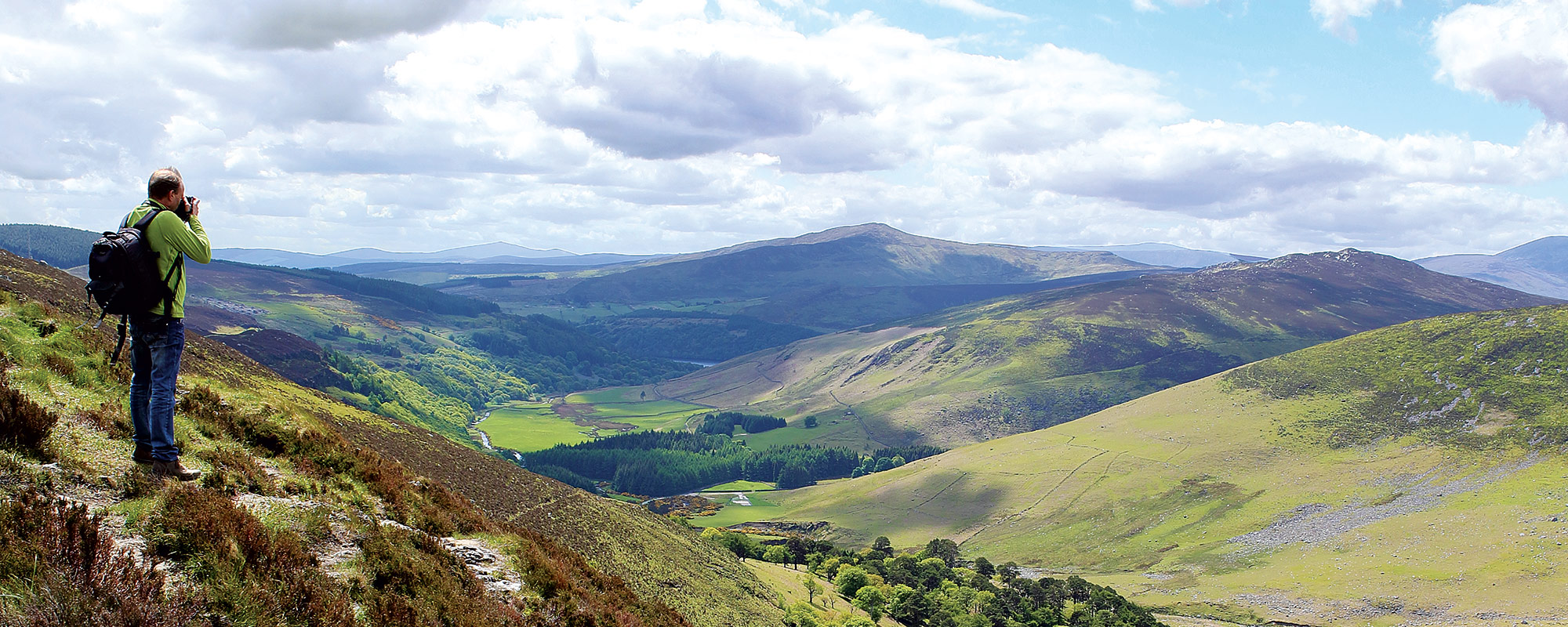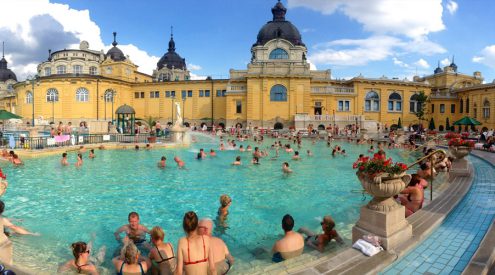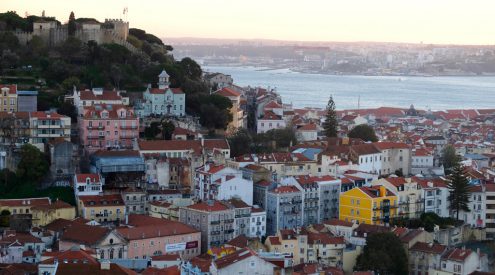Ireland’s capital Dublin is roaring strong – so much so it’s bidding to be European Capital of Culture. Here’s why it stands a good chance (and why you should go), writes Kerryn Fischer. Photographs by Elsa Young.
Why it’s worth the trip
- It’s still possible to find good value on the rand in Dublin. There’s loads to see and do at a reasonable price.
- Dublin’s Transport in the city is relatively inexpensive and Dublin’s recently launched Leap Travel Card makes it even cheaper for tourists to get around.
- The city centre is populated with a wealth of world-class restaurants, bars and cafes.
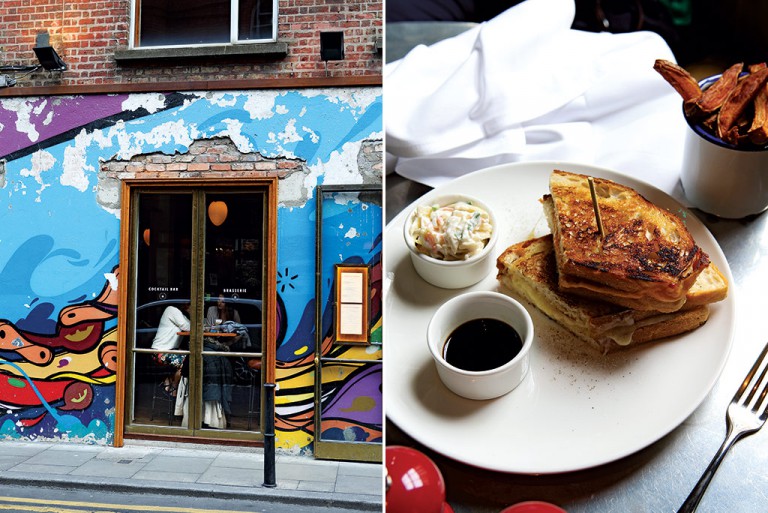
LEFT Colourful and stylishly tatty buildings on Drury Street; RIGHT You can’t do better than a toasted cheese and a Guinness at The Dean.
Little more than five years on from Ireland’s spectacular economic freefall, I arrive in Dublin for the first time, eager to taste a pint of Guinness in the city’s famous pubs and to walk through the hallowed halls of Trinity College. With its cobbled streets, gracious Georgian squares and strong literary tradition, I’d long wanted to explore this millennial city in person. There was none of the gloom and doom I had expected. Instead I found the locals witty and irrepressible, and the city centre populated with a wealth of world-class restaurants, bars and Cafés.
So unprepared was I for Dublin’s gastronomic fervour, that I cynically put my first meal, at Fade St Social, down to beginner’s luck. The food (service, ambience and superb wine list) at this buzzy restaurant and tapas bar owned by Dylan McGrath (a judge on MasterChef Ireland) was so ridiculously good that I feared nothing else could compare. But from morning coffee at Kaph on Drury Street, to clotted cream scones at The Woollen Mills, an Irish eatery with views over the Ha’penny Bridge and the River Liffey, to a bowl of giant crab claws at The Oar House in Howth, I was proved wrong over and over again.
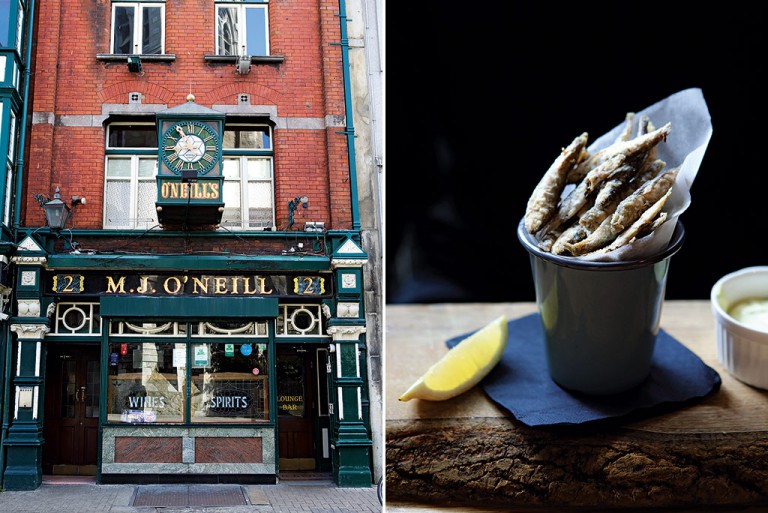
LEFT O’Neill’s pub is more than 300 years old; RIGHT Deep-fried whitebait at The Woollen Mills restaurant.
But then modern Ireland, according to many of the sanguine locals I spoke to, is the ultimate comeback kid. Not only is it dramatically different to its pre-boom days, but it’s also an altogether better place too. The generation who grew up in the Celtic Tiger years are generally more educated and confident than their forefathers – and more entrepreneurially savvy. And when you consider that the city was ruled by the Vikings for nearly three centuries, you begin to appreciate that an innate sense of adaptability may be central to the country’s bullish recovery. (No wonder South Africans and the Irish have such an affinity.) And the most obvious manifestation of this is in its newfound attitude to food and culture, both formally identified as significant growth sectors for the city.
Dublin is accessible
I found navigating Dublin on foot an easy and inexpensive way to experience the city. I started at Grand Canal Square in Docklands, home to the country’s largest purpose-built theatre, the Bord Gáis Energy Theatre. It’s an important cultural location, as it was designed to present theatrical productions that were previously unable to visit Ireland.
Next door is the equally impressive hotel The Marker, that was much maligned by critics for its plasticised exterior. I found its six-storey chequerboard facade a stellar addition to the city’s landscape and its interiors a marvel of honeycomb internal walls. To sit in the hotel’s rooftop bar looking out to sea, with a cocktail and a punnet of delicious bar snacks in hand, remains one of my most memorable Dublin moments.
The city has a great and inexpensive bike-share scheme and so I spent a morning cycling to some of the more than 20 bridges that cross the River Liffey. Starting at Docklands, I headed up along the river through the city. Each bridge offers a glimpse into Dublin’s chequered yet fascinating past, and celebrates the life of a personality such as Samuel Beckett or Rosie Hackett. Dublin Castle is another must-do, with an ongoing cultural programme of art and theatre. The entrance fee is not extortionate, even by South African standards, and entry is free on a Wednesday. Most tourists don’t know about Dubh Linn Garden that is part of the castle grounds. The garden is the site of the original dubh linn or ‘black pool’ from which the city derives its name.
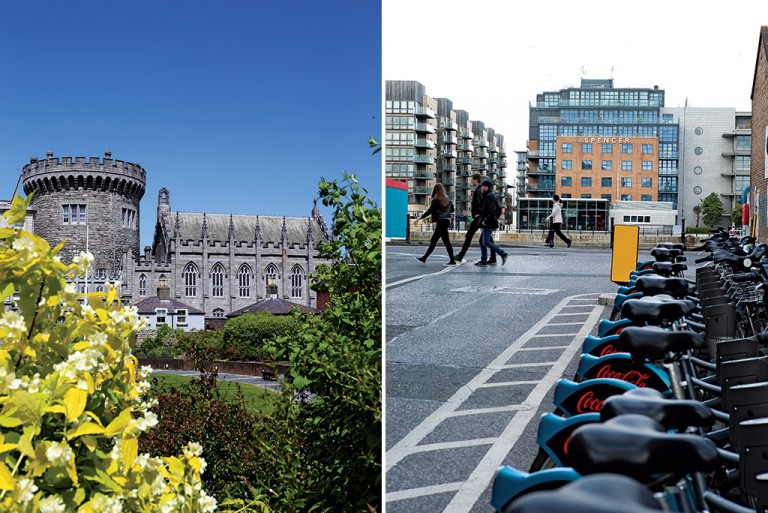
LEFT Dublin Castle is a must-visit; RIGHT The Spencer Hotel overlooks the Grand Canal in Docklands.
For the Dublin of old, there’s no better place than the library at Trinity College. More than 300 years old, the 64-metre Long Room is worth seeing with its barrel-vaulted ceiling and marble busts of famous writers lining the walkways. You can also see the Book of Kells, a lavishly decorated manuscript containing the four Gospels of the New Testament.
For those more inclined towards a beer and live music, head straight to Temple Bar on the south bank – although, be warned, you may pay more for your pint here. Despite its raucous reputation, this vibey neighbourhood with its cobbled streets lined with cafés and bars, is home to one of the city’s art-house cinemas, as well as the Gallery of Photography and the Project Arts Centre. In the early evening the streets around this well-known area take on a life of their own as popular pubs fill up and the city’s endless stream of performers take to the streets.
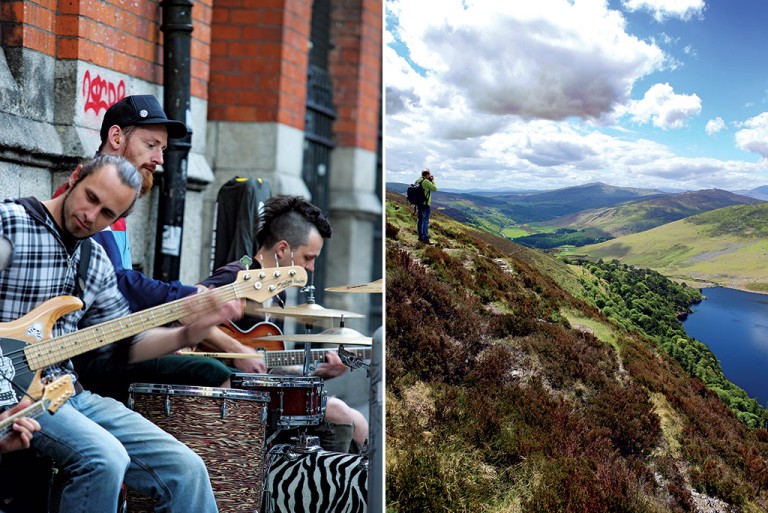
LEFT Street performers on O’Connell Street; RIGHT The view over Lough Tay, often called the Guinness Lake, in County Wicklow.
The food is exceptional
Real social change can be seen in the country’s seismic shift in attitude to food. Irish food has always been hearty and filling, if a little thin in repertoire, and was characterised by Irish stews, Guinness pies and colcannon (mashed potatoes and cabbage) – all guaranteed to ‘warm the cockles’. Today its food is far more diverse and sophisticated. This is due, in no small part, to the country’s ability to hold onto its farming industry, thus thwarting the mass industrialisation that has dogged the quality food sector elsewhere. In turn, this has given rise to a homegrown, artisanal food culture that has brought about a new confidence in the quality and variety of Irish produce. So much so that the standard of food is causing as much of a stir as the country’s restaurants.
Inspired to learn more, I booked myself on a three-hour Fabulous Food Trail, essentially a guided walking tour that takes you to bakeries, restaurants, food halls, markets and speciality shops around the city. It’s a wonderful way to see the city on foot, but also a fascinating insight into Ireland’s incredible gastronomic journey thus far. I tasted estate venison, grass-fed free-range beef, organic salmon and hand-dived scallops.
I also discovered incredible artisanal cheeses, the joy of rich yellow country butter and the deliciously nutty taste of a Comber potato. Coming across this potato from Northern Ireland was all the more fascinating because it is one of an elite group of high-quality European products, such as Parma ham and Stilton cheese, that has protected geological status under European law. So much for the simple spud.
My impressions of Dublin were of a city at ease with itself, and a populace that is both grounded and engaged. My many conversations with locals reminded me again and again of a typically abrupt Irish proverb that says: you can put silk on a goat, but it is still a goat. For while the city offers world-class experiences at every turn, the locals’ sense of humour is intact and they have no intention of losing their sense of self again. In fact, the crash and resultant soul-searching that ensued have given way to a cultural renaissance on every level. Here’s hoping they win their bid to become European Capital of Culture in 2020, I can’t wait to see what dizzying heights they’ll be achieving by then.

Dublin travel guide
Best time to visit Dublin
It’s best to visit in summer but expect higher prices. Winter is better on the budget but there are fewer events and festivals. The fringe seasons are a happy medium.
Need to know
South Africans don’t need a visa to visit. The currency is the euro, so things can get expensive, but there are ways to save on costs, especially transport. The city launched its Leap Visitor Card last year – a prepaid card that gives visitors unlimited travel for 72 hours. It costs R397 and can be used on all bus services, Luas trams, the DART rail line to Howth and the Commuter Rail service in the short-hop zone. It also includes an airport to city return trip on Airlink. Buy it in the Spar shop in the arrivals hall of Terminal 1 or 2, or at the Tourist Information Desk at Dublin Airport.
There’s also the Coca-Cola Zero bike-share scheme with stations throughout the city where you can drop off and pick up bicycles. R75 for a three-day ticket.
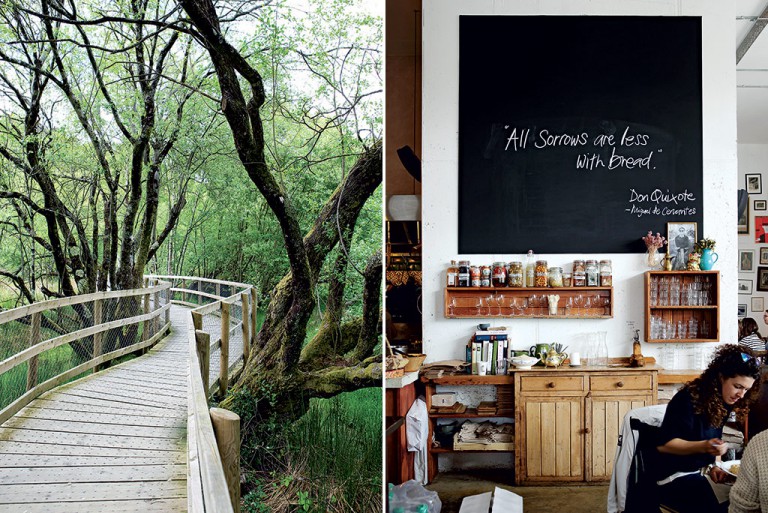
LEFT A beautiful boardwalk in Glendalough in County Wicklow – a wonderful antidote to the busy streets of Dublin; RIGHT The Fumbally serves good food and coffee.
What to do in Dublin
1. The Dublin Literary Pub Crawl
Do the Dublin Literary Pub Crawl, a funny, award-winning show hosted by professional actors who perform from the works of Dublin’s most famous writers – Joyce, Beckett, Wilde, Behan and many more, as you ‘crawl’ from pub to pub. It costs R196 and starts at 7:30pm every night (in summer) at The Duke.
Contact: Tel +35316705602, dublinpubcrawl.com
2. Visit Howth
Take a boat tour to the picturesque fishing village of Howth and have a lunch of giant crab’s claws at The Oar House Restaurant. A return ticket costs R420 and so does a large bowl of claws (can be shared).
Contact: Tel +35319011757, dublinbaycruises.com
3. The Wild Wicklow Tour
Join the Wild Wicklow Tour to wonderful locations such as Powerscourt, Glendalough, and The Sally Gap in County Wicklow. It’s a day-long tour and costs R420.
Contact: Tel +35312801899, wildwicklow.ie
4. Trinity College
Visit the library at Trinity College to bone up on Irish history and walk the 64-metre Long Room that is home to more than 200000 books. Entrance is R150.
Contact: Tel +35318962320, tcd.ie
5. The Bord Gáis Energy Theatre
See a show at the Bord Gáis Energy Theatre. There’s everything from ballet and opera to music. Tickets from R250.
Contact: Tel +35316777999, bordgaisenergytheatre.ie
6. Dublin Castle
Visit Dublin Castle and its garden – the site from which the city derives its name. Entrance is R98 (free on the first Wednesday of every month).
Contact: Tel +35316458813, dublincastle.ie
7. The Gallery of Photography
Browse the Gallery of Photography. Exhibitions change regularly and entrance is free.
Contact: Tel +35316714654, galleryofphotography.ie
8. The Projects Art Centre
Visit the Projects Art Centre for contemporary theatre, art and music. Shows from R75.
Contact: Tel +35318819613, projectartscentre.ie
9. The Dublin Tasting Trail
Do the Dublin Tasting Trail and visit bakeries, food halls, street markets and more, all the while learning about the city’s history and culture through its food. From R830 per person.
Contact: Tel +35314971245, fabfoodtrails.ie
Where to eat and drink in Dublin
1. Kaph
Kaph makes great coffee and has an excellent assortment of chocolate. Cappuccino from R45.
Contact: Tel +35316139030.
2. Woollen Mills Restaurant
The Woollen Mills Restaurant is a quintessentially Irish ‘Eating House’ situated in one of the city’s most iconic buildings. Food is locally sourced and it’s great for breakfast, lunch or just coffee. Lunch from R150.
Contact: Tel +35318280835.
3. Fade St Social
Fade St Social is a buzzy restaurant and tapas bar with a menu sourced from local ingredients. The impeccable food is matched only by an incredible wine list. Tapas from R75.
Contact: Tel +35316040066.
4. Drury Buildings
Drury Buildings, with its graffiti-covered exterior, exudes urban cool and is a great place to meet for a bite. Lunch from R166.
Contact: Tel +35319602095.
5. The Fumbally
The Fumbally, a little outside of the city centre, has great breakfasts, good coffee and there’s always an interesting crowd. Eggs from R75.
Contact: Tel +35315298732.
6. O’Neill’s Bar and Restaurant
O’Neill’s Bar and Restaurant is an example of a traditional pub and is as good a place for a raucous night out as it is for a quiet pint. A pint of Guinness costs R75.
Contact: Tel +35316793656.
Where to stay in Dublin
1. The Dean Hotel
The Dean Hotel is relatively affordable and vibey with a great rooftop restaurant and bar and beautifully decorated bedrooms. From R1664 (sleeps two).
Contact: Tel +35316078110.
2. Trinity City Hotel
Trinity City Hotel is super central and has an excellent breakfast buffet. Look past the purple velvet in the reception area and ask for a room away from the fire station, or you’ll be privy to night-long fire drills. B&B from R1300 per person sharing.
Contact: Tel +35316481000.
3. The Marker Hotel
The Marker Hotel is a fantastic hotel in Docklands designed by Portugal’s Studio Mateus. Its rooftop bar and terrace is perfect for an early evening cocktail and its location across the way from the Bord Gáis Energy Theatre also makes it a great option for pre-theatre dinner. Rooms from R2100 per person sharing.
Contact: Tel +35316875100.
4. The Clarence Hotel
The Clarence Hotel (owned by the group U2) feels a little more formal and moneyed and is great for those who want a bit of space. Rooms from R1800 (sleeps two).
Contact: Tel +35314070800.
This story first appeared in the December 2015 issue of Getaway magazine.
Get this issue →
All prices and contact details correct at publication, but are subject to change at each establishment’s discretion.
